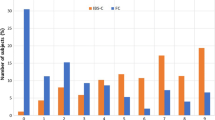Abstract
Modern methods of diagnosing diarrhea-predominant irritable bowel syndrome (D-IBS) require a “diagnosis of exclusion” approach. In this study we aim to test the diagnostic ability of using the fluctuation of frequency and consistency of bowel patterns in IBS to discriminate it from other causes of diarrhea. Eligible subjects were asked to complete a questionnaire on the changes in form and frequency of bowel habits by time. The primary endpoint was to evaluate the diagnostic effectiveness of having irregularly irregular bowel function and form as more characteristic of IBS versus non-IBS causes. Patients were prospectively recruited from a tertiary care GI clinic. Subjects had to have diarrhea as their primary complaint. In the case of IBS, D-IBS subjects were recruited. Subjects with celiac disease, Crohn’s and ulcerative colitis were recruited for comparison and were categorically called “non-IBS.” Non-IBS subjects could not have a recent history of blood in stool or a history of bowel surgery, fistulae or narcotic use. Sixty-two IBS and 37 non-IBS subjects were recruited. Among the 62 IBS subjects, 49 (79%) stated that their bowel habits varied in form and frequency on a daily basis compared to 35% in non-IBS subjects (OR = 8.9,CI = 3.5–22.5, P < 0.00001). When subjects were compared by the number of different stool forms they had witnessed in the prior week, IBS subjects noted 3.58 ± 0.19 types and non-IBS reported 2.35 ± 0.16 (P < 0.00001). Using ≥3 stool forms per week as a method of discriminating IBS from non-IBS, 50 out of 62 subjects with IBS (81%) reported this greater number of forms compared to 15 out of 37 (41%) non-IBS subjects (sensitivity = 0.81; specificity = 0.60). The use of this simple tool that identifies an irregularly irregular bowel form and function is successful in separating D-IBS from non-IBS subjects.

Similar content being viewed by others
References
Bommelaer G, Poynard T, Le Pen C, et al. Prevalence of irritable bowel syndrome (IBS) and variability of diagnostic criteria. Gastroenterol Clin Biol. 2004;28:554–561. doi:10.1016/S0399-8320(04)95011-7.
Wilson S, Roberts L, Roalfe A, Bridge P, Singh S. Prevalence of irritable bowel syndrome: a community survey. Br J Gen Pract. 2004;54:495–502.
Gwee KA, Wee S, Wong ML, Png DJ. The prevalence, symptom characteristics, and impact of irritable bowel syndrome in an Asian urban community. Am J Gastroenterol. 2004;99:924–931. doi:10.1111/j.1572-0241.2004.04161.x.
El-Serag HB. Impact of irritable bowel syndrome: prevalence and effect on health-related quality of life. Rev Gastroenterol Disord. 2003;3(Suppl 2):S3–S11.
Hungin AP, Whorwell PJ, Tack J, Mearin F. The prevalence, patterns and impact of irritable bowel syndrome: an international survey of 40,000 subjects. Aliment Pharmacol Ther. 2003;17:643–650. doi:10.1046/j.1365-2036.2003.01456.x.
Agreus L, Svardsudd K, Nyren O, Tibblin G. Irritable bowel syndrome and dyspepsia in the general population: overlap and lack of stability over time. Gastroenterology. 1995;109:671–680. doi:10.1016/0016-5085(95)90373-9.
Bergmann JF. Inclusion and exclusion criteria of importance in irritable bowel syndrome trials. Am J Med. 1999;107:59S–64S. doi:10.1016/S0002-9343(99)00080-7.
Jones MP, Craig R, Olinger E. Small intestinal bacterial overgrowth is associated with irritable bowel syndrome: the cart lands squarely in front of the horse. Am J Gastroenterol. 2001;96:3204–3205. doi:10.1111/j.1572-0241.2001.05312.x.
Drossman DA, Richter JE, Talley NJ, et al., eds. Functional Gastrointestinal Disorders: Diagnosis, Pathophysiology and Treatment: A Multinational Consensus. Boston: Little, Brown; 1994.
Thompson WG, Longstreth GF, Drossman DA, et al. Functional bowel disorders and functional abdominal pain. Gut. 1999;45:II43–II47.
Rome Foundation. Guidelines—Rome III diagnostic criteria for functional gastrointestinal disorders. J Gastrointestin Liver Dis. 2006;15:301–312.
Lembo TJ, Fink RN. Clinical assessment of irritable bowel syndrome. J Clin Gastroenterol. 2002;35:S31–S36. doi:10.1097/00004836-200207001-00007.
Talley NJ. When to conduct testing in patients with suspected irritable bowel syndrome. Rev Gastroenterol Disord. 2003;3 (Suppl 3):S18–S24.
Marsh MM. Gluten major histocompatibility complex, and the small intestine. A molecular and immunobiologic approach to the spectrum of gluten sensitivity (‘celiac sprue’). Gastroenterol. 1992;102:330–354.
Lacy BE, Rosemore J, Robertson D, et al. Physicians’ attitude and practices in the evaluation and treatment of irritable bowel syndrome. Scand J Gastroenterol. 2006;41:892–902. doi:10.1080/00365520600554451.
Vanner SJ, Depew WT, Paterson WG, et al. Predictive value of the Rome criteria for diagnosing the irritable bowel syndrome. Am J Gastroenterol. 1999;94:2912–2917. doi:10.1111/j.1572-0241.1999.01437.x.
Acknowledgment
Source of Support: Beatrice and Samuel A. Seaver Foundation
Author information
Authors and Affiliations
Corresponding author
Rights and permissions
About this article
Cite this article
Pimentel, M., Hwang, L., Melmed, G.Y. et al. New Clinical Method for Distinguishing D-IBS from Other Gastrointestinal Conditions Causing Diarrhea: The LA/IBS Diagnostic Strategy. Dig Dis Sci 55, 145–149 (2010). https://doi.org/10.1007/s10620-008-0694-z
Received:
Accepted:
Published:
Issue Date:
DOI: https://doi.org/10.1007/s10620-008-0694-z




